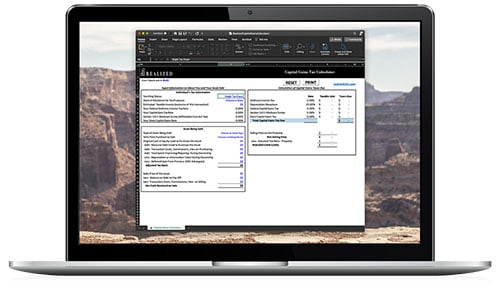
The sale of investment property is taxed differently than the sale of your primary residence. A primary residence allows you to exclude $250,000 of gains when filing single and $500,000 when married filing jointly.
Investment property tax calculations aren’t so simple. In this article, we’ll break down the various investment property capital gains tax calculations and provide a few tax-saving tips.
How Are Capital Gains Calculated?
Capital gains are calculated as short and long-term gains. Short-term gains apply to properties held for a year or less and are taxed at your income tax rate. Long-term gains, which are gains on a property held for more than a year, are taxed at a fixed rate.
The basic capital gains calculation on an investment property is fairly straight forward. Depending on your income, other capital gains tax calculations can come into play. This is what the capital gains formula looks like:
Capital gains = sale price - adjusted basis
The purchase price of the property is called the basis. The adjusted basis factors in improvements, legal fees, depreciation, and losses. The adjusted basis calculation is:
Adjusted basis = purchase price + improvements + legal fees - depreciation - insurance reimbursements from losses
If the difference between the sale price and the adjusted basis is positive, there’s a capital gain. In the next section, we discuss options for handling capital gains taxes.
Unlike the progressive income tax structure, capital gains taxes are applied equally to all gains. For 2019, the capital gains rates are 0%, 15%, and 20%. These rates are income dependent. Additionally, state taxes must be paid on any gains. When selling a property, you also receive your original investment, which is a tax-free return of capital, since there is no gain.
There are a few things to unpack in regard to depreciation. The IRS determines a useful life for a property. You accumulate deprecation for each year you hold the property. This annual depreciation is a percentage of the total useful life. For example, if a property has a useful life of 27 years and you hold it for five years, your annual depreciation is 1/27 for a total of 5/27 (18.5% of the useful life).
The IRS has been keeping a tab of all your annual depreciation deductions. Once the property is sold, they’ll have a bill ready for you so they can get back part of that depreciation. This is called depreciation recapture. It is based on your income and is capped at 25%. Be sure to plan for this tax bill.
The Net Investment Income Tax (NIIT), which is is 3.8%, must be paid by high-income earners. It applies to those filing single, with an income of $200,000 or married filing jointly with an income of $250,000.
What Are My Options After I Sell?
In no particular order, the first option, which is also the most expensive, is to pay the tax bill and pocket the remaining proceeds.
A second option is a 1031 Exchange. A 1031 lets you roll the basis forward into another property. The result is a deferral of taxes on depreciation and capital gains. A qualified intermediary is needed to execute a 1031. Money from the sale of the property can never touch your hands. It must all be handled by the intermediary.
There are some timeframe restrictions on a 1031 that must be observed. You have 180 days from the sale of a property to complete a 1031 exchange. You have 45 days from the sale of a property to identify up to three replacement properties. It’s best to identify replacement properties before starting the 1031 exchange process. Otherwise, you may find yourself extremely rushed with few opportunities.
A third option is to invest capital gains into a Qualified Opportunity Zone Fund (QOZF). A QOZF allows you to reduce taxes on gains. Any gains must be invested into a QOZF within six months of an investment property sale. QOZF tax benefits are applied on a stepped-up basis:
- Five-year Hold — 10% step-up in basis
- Ten-year Hold — dismissal of any capital gains tax derived from the fund itself and after the initial investment.
When you defer your capital gains tax bill and reinvest either through a 1031 exchange or QOZ Fund, the money that would have been paid in taxes instead remains invested, which in turn creates an opportunity for more income and wealth. Many real estate investors have accumulated fortunes over their lifetimes by completing exchanges each time they sell, keeping more of their money.
Information is based on data gathered from what we believe are reliable sources. It is not guaranteed as to accuracy, does not purport to be complete and is not intended to be used as a primary basis for investment decisions. It should also not be construed as advice meeting the particular investment needs of any investor.
Realized does not offer legal or tax advice. The application and impact of tax laws can vary widely based on the specific facts involved. As such, this information should not be used as a substitute for consultation with professional accounting, tax, legal or other competent advisers. Before making any decision or taking any action, you should consult with a qualified professional.


